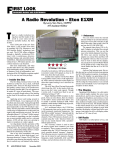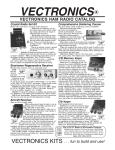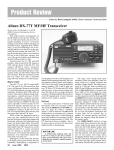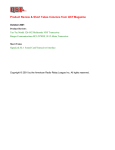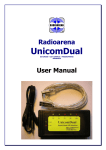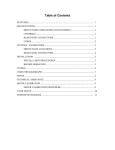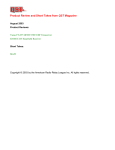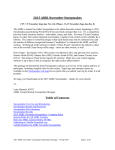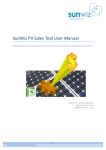Download Product Review & Short Takes Columns from QST Magazine
Transcript
http://www.rv3apm.com/KB.html Product Review & Short Takes Columns from QST Magazine February, 2003 Product Reviews High Power Antenna Tuners: • AMERITRON ATR-30 • MFJ-986 • PALSTAR AT1500CV • TEN-TEC 238A • VECTRONICS HFT-1500 Short Takes Zapchecker Gregoire TR-2000 Communications Headset Copyright © 2002 by the American Radio Relay League Inc. All rights reserved. http://www.rv3apm.com/KB.html PRODUCT REVIEW QST Reviews Five High-Power Antenna Tuners Reviewed by Jim Parise, W1UK, ARRL Technical Advisor One piece of gear that finds its way into most everyone’s shack at one time or another is an HF antenna tuner. First of all, the name “antenna tuner” is something of a misnomer. It does not tune the antenna at all, but acts as an impedance transformer that provides your transmitting equipment with the proper load, usually 50 Ω. Who needs an antenna tuner? Well, anyone who has the need to match an antenna with an impedance outside the range of their transmitter or amplifier’s output circuits. Modern transceivers typically have built-in tuners that are capable of matching SWR mismatches up to 3:1. Beyond that they need help, and if you use an amplifier you most surely will need one. Many hams find themselves with limited antenna choices and the desire to operate on frequencies other than what they were designed for, or use non-resonant multiband antennas that require a tuner. The five HF tuners we tested are all in the kilowatt class, meaning the manufacturer rates their power handling capability at 1 kW output or more. With the wide range of frequencies in the HF spectrum and the huge diversity of antenna types in use, tuners are expected to perform under an incredible number of possible combinations. Some are more efficient at it than others. A measure of a tuner’s ability to transform impedances efficiently is energy loss. Under extreme conditions a tuner can get quite hot or arc over at power levels well under the manufacturers rating. Heat in a tuner is a product of loss. RF energy being dissipated as heat is lost power that will not find its way to your antenna and onto the air. Tuner losses generally get higher as the impedance of the load decreases. If a ham were running 1500 watts into a tuner that was 50% efficient, 750 watts would be dissipated in the tuner. Most of the loss in a tuner occurs in the coil, and no coil can withstand 750 watts of power. A high-power tuner could probably be safely used at 50% efficiency and 100 watts, but hams should be careful with high SWR and high power, or a tuner failure is a real possibility. Each tuner was tested into impedances that ranged from 6.25 to 400 Ω, and their respective percentage of loss and 1.5-SWR bandwidth measured. The tuners were also used in everyday communications on all bands at power levels up to 1 kW, matching a G5RV fed with balanced ladder line and a 160meter inverted L fed with coax. Table 1 Comparison of Five Antenna Tuners Ameritron ATR-30 MFJ MFJ-986 Palstar AT1500CV Ten-Tec 238A Vectronics HFT-1500 Circuit type T-network T-network T-network L-network T-network SWR/wattmeter Cross-needle Cross-needle Cross-needle Single-needle Cross-needle Balun type 4:1 current 4:1 current 4:1 voltage 4:1 voltage 4:1 voltage Manufacturer’s claimed PEP rating 3000 W 3000 W 1500 W 2000 W 2000 W Manufacturer’s claimed matching range 35-500 Ω 35-500 Ω 20-1500 Ω 5-3000 Ω Not specified Physical dimensions (HWD) in inches 5.25×13×14.4 4.1×11×15.2 4.5×12.5×12 5.5×13×11 5.5×12.5×12 Brennan Price, N4QX Assistant Technical Editor [email protected] From February 2003 QST © ARRL http://www.rv3apm.com/KB.html AMERITRON ATR-30 The ATR-30 is Ameritron’s legal limit T-network antenna tuner offering. It is housed in a plain, all black aluminum enclosure with a scratch resistant coated front panel. A look under the cover reveals two large variable capacitors and an air core edge wound silver plated roller inductor. Like most of the other tuners reviewed here, the capacitors are adjusted with vernier reduction drives, and although they tune smoothly, they require a lot of force to turn. The roller inductor is adjusted with a plastic lever type knob and is quite stiff to crank. The roller itself is a pinch roller, and the physical resistance in turning the crank may be offset by lessoned contact resistance. The balun is constructed with three large cores and wound with wire covered with Teflon tubing. The cross-needle meter displays both average and peak power in switchable 300 W or 3 kW ranges. The wattmeter requires dc to function. It is illuminated by either a 12-V barrel connector on the back panel or a 9-V battery accessible through a trap door on the bottom of the unit. With 12 V, both the meter and inductor turns counter are illuminated. When a 9-V battery is used, the meter will function, but the panel lamps will not light. Finding a match on 80 meters on the G5RV required quite a bit of time finding the right combination of capacitor tuning and inductance, and the stiff controls didn’t make it much fun. Finding the sweet spot on the higher bands was much easier. There are three coax outputs on the ATR-30, including two that may be switched direct or through the T-network and a third direct only. Single or balanced feed lines connect to large ceramic binding posts with wing nuts. Manufacturer: Ameritron, 116 Willow Rd, Starkville, MS 39759; tel 662-323-8211; fax 662-323-6551; www. ameritron.com. Price: $599.95. Front panel of the Ameritron ATR-30. From February 2003 QST © ARRL Table 2 Ameritron ATR-30 SWR 8:1 Load (Ω) 6.25 4.1 12.5 2:1 25 1:1 50 2:1 100 4:1 200 8:1 400 Power Loss % 1.5 SWR BW Power Loss % 1.5 SWR BW Power Loss % 1.5 SWR BW Power Loss % 1.5 SWR BW Power Loss % 1.5 SWR BW Power Loss % 1.5 SWR BW Power Loss % 1.5 SWR BW 160 m 20 1 15 3 10 4 <10 >5 <10 >5 <10 >5 <10 >5 80 m 12 3 <10 4 <10 >5 <10 >5 <10 >5 <10 >5 <10 >5 40 m <10 >5 <10 >5 <10 >5 <10 >5 <10 >5 <10 >5 <10 >5 20 m <10 4 <10 >5 <10 >5 <10 >5 <10 >5 <10 >5 <10 >5 10 m <10 >5 <10 >5 <10 >5 <10 >5 <10 >5 <10 5 <10 3 Notes Power losses are expressed as a percentage. A 21% loss of power is 1 dB. The 1.5-SWR Bandwidth (SWR BW) represents the bandwidth over which an SWR of 1.5:1 or less was maintained as a percentage of the measurement frequencies (1.8, 3.5, 7.2, 14.2 and 29.7 MHz). Interior circuitry of the Ameritron ATR-30. Rear panel connections on the Ameritron ATR-30. http://www.rv3apm.com/KB.html MFJ-986 The 986 is one of more than 20 antenna tuner products currently offered by the prolific MFJ. It is rated for 1500 W PEP within the 35-500 Ω impedance range, positioning it alongside the 989C as one of their high power units. Unlike the traditional T-network with a pair of variable capacitors, the 986 makes use of a single variable capacitor and a wire wound air core roller inductor with a three digit turns counter. The tuner uses what MFJ describes as a “differential” capacitor. It has two discrete sets of fixed plates and one variable set, with a single capacitor control, forming a T-network with the inductor. The cabinet is narrow and extends nearly 18 inches deep. The cross-needle meter has a high (3000 W) and low (300 W) setting switched by a front panel button, and it can display average and peak power as well as SWR. Providing 12 V to the connector on the back panel brightly illuminates the meter. Both the capacitor and roller inductor are directly driven. The inductance knob has a finger depression, such as often found on a transceiver’s tuning knob. It is somewhat awkward to turn due to binding. The tuner had a tendency to creep around the operating desk when the inductor is rapidly turned. A check inside revealed several loose screws holding the inductor to the chassis. Tightening these did improve the smoothness somewhat. The 986 provided a match to both antennas quickly, but arced over on 80 meters with the inverted L at 900 W. While this tuner does provide ease of use, one should give careful consideration to the loss figures in the tables. During operation the meter developed an intermittent problem with both needles going off scale even with very low power applied and a low SWR. Movement of the SWR bridge circuit board on the inside back panel seemed to correct the problem. Two coax outputs are provided that can be switched to bypass the tuning circuit, Front panel of the MFJ-986. Table 3 MFJ-986 SWR 8:1 Load (Ω) 6.25 4.1 12.5 2:1 25 1:1 50 2:1 100 4:1 200 8:1 400 Power Loss % 1.5 SWR BW Power Loss % 1.5 SWR BW Power Loss % 1.5 SWR BW Power Loss % 1.5 SWR BW Power Loss % 1.5 SWR BW Power Loss % 1.5 SWR BW Power Loss % 1.5 SWR BW 160 m 47 1 33 1 25 1 22 2 15 3 11 3 10 3 80 m 31 1 22 1 20 2 12 3 10 5 <10 >5 <10 >5 40 m 21 2 14 4 10 4 <10 >5 <10 >5 <10 >5 <10 >5 20 m 16 4 12 5 <10 >5 <10 >5 <10 >5 <10 >5 11 >5 10 m 13 >5 11 >5 10 >5 <10 >5 19 >5 <10 >5 16 5 Notes Power losses are expressed as a percentage. A 21% loss of power is 1 dB. The 1.5-SWR Bandwidth (SWR BW) represents the bandwidth over which an SWR of 1.5:1 or less was maintained as a percentage of the measurement frequencies (1.8, 3.5, 7.2, 14.2 and 29.7 MHz). Interior circuitry of the MFJ-986. When viewed from the side, two sets of fixed plates are seen on the differential capacitor. as well as a third output for a dummy load. Balanced and single-wire feed lines connect to large ceramic feed through posts with wing nuts. A 4:1 two-core current balun is provided at the output. Manufacturer: MFJ Enterprises, Inc, PO Box 494, Mississippi State, MS 39762; tel 800-647-1800; fax 662-3236551; www.mfjenterprises.com. Price: $329.95. Rear panel connections on the MFJ-986. From February 2003 QST © ARRL http://www.rv3apm.com/KB.html PALSTAR AT1500CV The Palstar AT1500CV is a T-network tuner solidly constructed in a compact aluminum enclosure. Inside, the metering and SWR bridge circuitry are encased in their own aluminum boxes. The moderately sized variable capacitors are mounted side by side and feature large calibrated dials and silky smooth vernier tuning that allows for precise adjustment. Palstar indicates that newer units incorporate a roller bearing assembly which makes inductor adjustment smoother. The roller inductor is quite large. It is an air core silver plated edge wound coil with heavy-duty ceramic forms. Control of the inductor is via a lever handle and mechanical turns counter. It is not as smooth as some of the other tuners and tends to lurch as it is rotated during fine adjustments. The cross-needle meter displays SWR and average forward and reflected power in 300 and 3000 W ranges, with no option for peak power metering. It is illuminated with 12 V from an included wall adapter. Achieving a 1:1 SWR on the G5RV was possible on all bands from 80 through 10 meters at its rated power maximum of 1000 W single tone. Similar results were noted on the inverted L. Although the tuning chart provided in the manual does not include settings for 30 meters, the tuner easily matched both antennas on that band. This tuner has a solid feel to it and doesn’t creep around while making adjustments. In laboratory tests, the AT1500CV had more difficulties on 160 meters than on other bands. A 1:1 SWR was only obtainable with the 25 and 50-Ω loads. Even at those loads, the power losses at 160 meters were measurably greater than those on other bands at the same loads. The variable capacitors are 240 pF maximum, which explains the 160 meter performance. The tradeoff results in lighter weight. Antenna connections on the back panel include three coax inputs. Two are available direct or through the tuning network and one is bypassed straight through. The bypass output can also be used with an optional 4:1 balun available for $39.95. Balanced or single wire feed lines are attached to Delrin terminal posts with wing Front panel of the Palstar AT1500CV. From February 2003 QST © ARRL Table 4 Palstar AT1500CV SWR 8:1 Load (Ω) 6.25 4.1 12.5 2:1 25 1:1 50 2:1 100 4:1 200 8:1 400 Power Loss % 1.5 SWR BW Power Loss % 1.5 SWR BW Power Loss % 1.5 SWR BW Power Loss % 1.5 SWR BW Power Loss % 1.5 SWR BW Power Loss % 1.5 SWR BW Power Loss % 1.5 SWR BW 160 m No Match No Match 21 2 13 3 No Match No Match No Match 80 m 25 1 16 2 13 3 <10 >5 <10 >5 <10 >5 <10 >5 40 m 16 2 13 4 <10 >5 <10 >5 <10 >5 <10 >5 <10 >5 20 m 12 >5 <10 >5 <10 >5 <10 >5 <10 >5 <10 >5 <10 >5 10 m 12 3 11 >5 <10 >5 <10 >5 13 >5 12 >5 <10 5 Notes “No Match” means that a 1:1 SWR could not be obtained. Power losses are expressed as a percentage. A 21% loss of power is 1 dB. The 1.5-SWR Bandwidth (SWR BW) represents the bandwidth over which an SWR of 1.5:1 or less was maintained as a percentage of the measurement frequencies (1.8, 3.5, 7.2, 14.2 and 29.7 MHz). nuts. Longer threaded material on the terminal posts would be a welcome improvement and make attachment of larger gauge wire much easier. In one isolated circumstance during lab testing, our engineer felt an RF bite on 10 meters through the metal portion of the inductor crank. This did not seem to be a pervasive problem, and Palstar indicates that the grounding on the crank has also recently been improved. Manufacturer: Palstar, Inc, 9676 N Looney Rd, PO Box 1136, Piqua, OH 45356; tel 937-773-6255; fax 937-7738003; www.palstarinc.com. Price: $429.95, optional 4:1 balun $39.95. Interior circuitry of the Palstar AT1500CV. Rear panel connections on the Palstar AT1500CV. TEN-TEC 238A The Ten-Tec 238A is the only tuner in our roundup to utilize an L-network. Using an innovative switching arrangement, the 238A actually provides five different circuit configurations to maximize efficiency. A look at the low loss figures in the table confirms this. The well-constructed tuner makes us of a single variable capacitor and a smooth turning wire wound roller inductor to match impedances up to 3000 Ω. Additional capacitance is switched into the circuit by means of a front panel switch. Five settings each are available for high and low impedances, as well as a bypass choice. A ceramic feed through post on the back panel provides a connection to add an additional 1000 pF capacitor (included with the tuner) to the circuit for matching 160 meter antennas. The small dual use meter can be switched to display SWR or RF power in either a 2000 or 200 W range. The meter lamp is powered by 12 V on the back panel. The 238A handily matched all bands on both test antennas at full legal limit power. On 10 meters using the G5RV, the capacitor and inductor controls were a bit sensitive to small adjustments. One minor complaint: Measuring forward power in the high power range on the meter caused the indicator to slap the right extreme position during CW keying. In laboratory tests, the 238A did not match on 160 meters into a 6.25-Ω load until 2700 pF of external capacitance was added. Ten-Tec indicates they will provide additional capacitors to purchasers at no extra charge. Also, the power losses on 10 meters were considerably greater than those on other bands. However, the 238A performed very admirably on most other bands, quite often exhibiting the least losses on given band and load combinations. The four-position antenna switch on the front panel allows selection of four coax outputs or a balanced/random wire. The balanced output and one coax connector share position four. A two-core balun is provided for matching the balanced output. Front panel of the Ten-Tec 238A. Table 5 Ten-Tec 238A SWR 8:1 Load (Ω) 6.25 4.1 12.5 2:1 25 1:1 50 2:1 100 4:1 200 8:1 400 Power Loss % 1.5 SWR BW Power Loss % 1.5 SWR BW Power Loss % 1.5 SWR BW Power Loss % 1.5 SWR BW Power Loss % 1.5 SWR BW Power Loss % 1.5 SWR BW Power Loss % 1.5 SWR BW 160 m No Match <10 >5 <10 >5 <10 >5 <10 >5 <10 >5 <10 >5 80 m <10 >5 10 >5 10 >5 <10 >5 <10 >5 <10 >5 <10 >5 40 m <10 >5 <10 >5 <10 >5 <10 >5 <10 >5 <10 >5 <10 >5 20 m <10 >5 <10 >5 <10 >5 <10 >5 <10 >5 <10 >5 10 >5 10 m 28 2 22 2 17 3 <10 >5 20 4 20 4 13 1 Notes “No Match” means that a 1:1 SWR could not be obtained, even with the included 1000 pF external capacitor attached. A match on 160 m at 6.25 Ω was achieved with 2700 pF of external capacitance; the power loss was less than 10%, and the 1.5 SWR BW was greater than 5%. Power losses are expressed as a percentage. A 21% loss of power is 1 dB. The 1.5-SWR Bandwidth (SWR BW) represents the bandwidth over which an SWR of 1.5:1 or less was maintained as a percentage of the measurement frequencies (1.8, 3.5, 7.2, 14.2 and 29.7 MHz). Since we purchased our review unit, Ten-Tec has produced a substantially identical antenna tuner, the 238B. The Tennessee manufacturer is now selling only the 238B model. Manufacturer: Ten-Tec, 1185 Dolly Parton Pky, Sevierville, TN 37862; tel 865-453-7172; fax 865-428-4483; www. tentec.com. Price: $475.00 (current model 238B). Interior circuitry of the Ten-Tec 238A. The 238A is the only one of the five tuners reviewed here without an air-core inductor. The inductor here has a linen phenolic core. Rear panel connections on the Ten-Tec 238A. From February 2003 QST © ARRL VECTRONICS HFT-1500 The first thing you notice about the HFT-1500 is the LED bar graph on the front panel, which is used to display relative peak forward power. The bright green bar graph is adjusted to its maximum scale with a level control on the front panel to a known forward power reading on the cross-needle wattmeter. While it doesn’t show actual power readings, it does give a quick visual indication of peak power. The cross-needle meter displays only average power and SWR in two power ranges selected by a pushbutton switch. The traditional Tnetwork design uses two 4.5-kV variable capacitors adjusted with large comfortable knobs and very smooth vernier tuning. This tuner stays put on the desk while you utilize a lever handle and gear driven 5 digit mechanical turns counter to adjust the air wound roller inductor. Tuning the 160-meter inverted L and the G5RV on all bands except 10 meters was easily accomplished, with no problems handling 1 kW. In the field, the best SWR that could be obtained on 10 was 2.33:1; this is possibly due to the additional “loading” when a human touches the all-metal inductor crank. The ARRL Lab adjusted the inductor with a wooden pencil in some cases to obtain a match. The HFT-1500 provides two coax inputs and a third that completely bypasses the tuning network. The balanced and single wire inputs are Delrin terminal posts connected to a large single core 4:1 voltage balun. In some circumstances during lab testing, our engineer felt RF bites through the metal portion of the inductor crank. Later units feature a metal shaft bushing, which provides a better ground. This was not experienced in field testing, but tuner adjustments were not made at high power. Manufacturer: Vectronics, 300 Industrial Park Rd, Starkville MS 39759; tel 662-323-5800; fax 662-323-6551; www.vectronics.com. Price: $459.95. Front panel of the Vectronics HFT-1500. From February 2003 QST © ARRL Table 6 Vectronics HFT-1500 SWR 8:1 Load (Ω) 6.25 4.1 12.5 2:1 25 1:1 50 2:1 100 4:1 200 8:1 400 Power Loss % 1.5 SWR BW Power Loss % 1.5 SWR BW Power Loss % 1.5 SWR BW Power Loss % 1.5 SWR BW Power Loss % 1.5 SWR BW Power Loss % 1.5 SWR BW Power Loss % 1.5 SWR BW 160 m 45 1 32 >5 19 2 12 3 12 3 <10 4 <10 4 80 m 42 <1 31 >5 24 1 <10 >5 <10 >5 <10 >5 <10 >5 40 m 16 2 11 3 <10 >5 <10 >5 <10 >5 <10 >5 <10 >5 20 m 15 5 <10 >5 <10 >5 <10 >5 <10 >5 <10 >5 11 >5 10 m 8 >5 <10 >5 <10 >5 <10 >5 <10 >5 <10 >5 16 4 Notes Power losses are expressed as a percentage. A 21% loss of power is 1 dB. The 1.5-SWR Bandwidth (SWR BW) represents the bandwidth over which an SWR of 1.5:1 or less was maintained as a percentage of the measurement frequencies (1.8, 3.5, 7.2, 14.2 and 29.7 MHz). Interior circuitry of the Vectronics HFT-1500. Rear panel connections on the Vectronics HFT-1500. Antenna Tuner Testing Methods vs Accuracy In the last round-up of manual antenna tuners, all of the test data was created using the test methods devised by Frank Witt, AI1H (described in depth in April and May 1995 QST). This method uses an antenna analyzer and measures changes in SWR with changes in loads on the tuner. That change in SWR can be used to calculate the tuner losses. Following the Product Review, we received some correspondence that suggested that the method was insufficient to produce “laboratory grade” accuracy in measurements. At the time, this prompted some further investigation on the part of ARRL Lab staff. The results of this study indicated that AI1H method was reasonable over the useful range of the tuners (the conditions for which the loss was reasonable). The Lab concluded at the time that the accuracy decreased as the tuner losses increased. When the Product Review Editor brought the Lab another collection of tuners to test, it was decided to employ a more direct method of loss measurement, and to perform many measurements by the AI1H method as well, so as to put the issue to rest. By comparing the two sets of results, a reasonable conclusion could be drawn about the correlation of both methods used. In this review, the method used to measure the loss of the tuners was as follows. Two test fixtures were built which would hold combinations of high power 50-Ω “non-inductive” carbon resistors (one fixture for parallel combinations and one for series). Even with the non-inductive resistors, some net fixture inductance was apparent at some frequencies, so a variable capacitor was used to compensate. The fixture accuracy was measured using the Lab’s vector impedance meter. Each fixture used an input connection (for the tuner) and an output connection. The output connection went to a 50-Ω input power attenuator, which took the place of one of the resistors in the load (for the series loads, it was always the one on the ground side of the network). The output of the power attenuator was connected to a high accuracy laboratory wattmeter, and the actual attenuation was measured for each frequency. The tuners were matched at low power, then 100 W of RF was applied at the input, with the output being measured by the Lab’s wattmeter. Because of the extra steps involved, the process was more time consuming than the AI1H method. Therefore, to reduce the required test time to a reasonable amount, the number of This is how each tuner was connected for testing in the ARRL Lab. A 100 W RF source (off picture rear) fed the input of the tuner. The resistive load was connected to the Ω power antenna output. The load was connected to a 50-Ω attenuator (off picture right), which took the place of the final resistors. tests were reduced by eliminating the 16:1 SWR tests (outside of the claimed matching range of most tuners) and by eliminating the balanced output tests (non-trivial to perform by the direct measurement method). The results of these “direct method” tests appear in the tables in this review. However, that still leaves the question of how the older test method compares with these results. Before getting into the nitty-gritty, it should first be noted that a variation of a few tenths of a decibel (excellent RF measurement precision indeed) translates to a significant difference in loss percentage for relatively low losses. That is to say that if one method indicates a loss of 3 percent and the other indicates a loss of 6 percent, a good portion of the difference is in the limits of the measurement accuracy. In comparing the results for both methods using the Lab’s test equipment, when the tuner losses were less than 20 percent, there was excellent correlation between measurement methods (loss differences of 2-3 percent). For losses between 20 and 40 percent, loss differences generally ranged around 5-6 percent, with a couple of measurements that differed by 7 percent. (An accuracy difference of 7% is about 0.3 dB.) In a “big picture” examination, the raw data seemed to suggest that one of the sources of error was related to the measurement of reactive components in an impedance measurement. This is part of the 2:1 SWR measurements made in the AI1H method. It appeared that for higher reactive values, the measurements were not being accurately reported by the antenna analyzer being used for the test. Given previous tests of antenna analyzers, this is not entirely surprising. The current spate of SWR analyzers in use by hams do a good job at measuring the SWR and impedance of antenna systems. However, expected variations in the manufacture of these types of equipment can lead to significant variations in the results, especially with resonant loads as found in matched antenna tuners. With the luck of the draw—as apparently happened with the ARRL Lab’s instrument—the accuracy can be quite good, but the next meter off the shelf might give different results under the same test conditions. Although the differences in terms of percentage might be relatively minor, reading 90% loss under circumstances where the loss was really 80%, this “10%” difference does mean a 3 dB change in the amount of power the tuner can safely dissipate under those conditions, possibly a consideration for the high-power operator. The bottom line is that the original test method was reasonably accurate, but not necessarily reproducible. To the extent practical, the Lab will continue to use the moreaccurate “direct” method for future testing. The AI1H method will still be used for some testing, but only with careful crosschecking of the instrumentation used.—Michael Tracy, KC1SX, ARRL Lab This is a close-up of the parallel load test fixture. The variable capacitor was used to compensate for fixture inductance encountered at some frequencies. From February 2003 QST © ARRL SHORT TAKES Zapchecker “Zapchecker” is an unusual name for a highly useful device. In essence, the Zapchecker is a wideband (10 MHz to 4.5 GHz) receiver that provides visual indications of the presence of RF energy. Common field-strength meters do the same thing, and they’ve been around for many years, but the Zapchecker takes the concept several steps further. The Zapchecker is a field-strength meter on steroids. First of all, it is quite sensitive. When I turned on the Zapchecker, I adjusted the sensitivity control to maximum, just to see what would happen. What happened was a pinned meter needle and a brightly glowing red LED. What was I picking up? The signal turned out to be emanating from the 900-MHz cordless telephone my wife was using in an adjacent room. After reducing the sensitivity considerably, I began walking around the house, waving the Zapchecker at any electronic device I could find. When I passed it within about a foot of my computer monitor, I saw a strong indication. No surprise there. My monitor generates plenty of RF, to my everlasting dismay. With the Zapchecker I was able to trace how RF was being radiated not only from my monitor, but from various interconnecting computer cables as well. The bright LEDs were a big help during this test. When I reached behind and beneath my station table, I couldn’t see the meter in the dim light, but the red and green LEDs were easy to read. The detecting antenna is the foam centered coil at top center. The red piece of paper is taped over the potentiometer swing point for protection. The motor at lower right generates the vibrations when this feature is turned on. The vibrations are pulsed by the LED at top right, which blinks (unseen) periodically while in vibrate mode. The motor does not run when the LED is lit. The ground wire to the batteries is connected to the right of R17 (bottom left); it was separated for this picture. A Lot of Features in a Tiny Package The Zapchecker is compact at only about 2 inches wide × 5 inches long × 1 inch thick, and it weighs just 5 ounces. It fits easily in your hand and can slip into a shirt or pants pocket. There are two switch-selectable measurement modes: Linear and Logarithmic. In the linear mode the Zapchecker has a maximum sensitivity of 100 µV at 10 MHz. In the logarithmic mode, the Zapchecker maintains a 45-dB logarithmic conformity. I found the linear mode to be best for detecting relatively weak signals, such as when I made some crude far-field pattern measurements of my HF antenna. The logarithmic mode is useful when you need to detect sudden changes in strength. This may come in handy during foxhunts when you are close to the “fox” transmitter. To test the idea, I concealed a transmitter in a small area of our backyard and challenged my 8-year-old daughter to find it with the Zapchecker. She managed to locate the fox in less than 10 minutes, and was so fascinated she wanted to do it again. The Zapchecker offers a unique feature that may be of interest to the visually impaired. You can enable a vibrator mode in which the Zapchecker will vibrate in varying degrees of strength when it detects signals. Serious Test Equipment Using the Zapchecker for a back yard fox hunt. The red LED glows when Zapchecker detects a strong signal. Steve Ford, WB8IMY From February 2003 QST © ARRL My encounter with the vibrator mode notwithstanding, the Zapchecker is a serious piece of test equipment. While testing the unit for this review, I used the Zapchecker to hunt down some RF leakage in our cable TV wiring. The sensitivity and ease of use made short work of what might have been a frustrating search. Manufacturer: Alan Broadband Company, 93 Arch St, Redwood City, CA 94062; tel 888-369-9627; www.zapchecker. com/. $89 plus $7 shipping and handling. QST Editor [email protected] SHORT TAKES Gregoire TR-2000 Communications Headset Reviewed by Steve Ford, WB8IMY I put a Warren Gregoire & Associates TR-2000 headset to the test during one of the most demanding phone contests of the year—the 2002 Sweepstakes. I knew that I’d gain a fair sense of what this low-cost headset could do within the first few hours of SSB bedlam. Before I could use the TR-2000, however, I had to adapt it to my ICOM IC-706 transceiver. Gregoire & Associates offer custom connector installation, but I opted for the hair-shirt approach of doing it myself. The TR2000 sports an electret microphone, which means that you must supply a polarizing voltage for it to operate. In the case of the TR2000 microphone, that was 9 V at about 100 µA. Like many modern transceivers, the IC-706 makes 9 V available at the microphone jack. The well-written instructions that accompany the TR-2000 advise you to Maty Weinberg, KA1EIB, models place a 10 kΩ resistor in the TR-2000 headset. series with the voltage source. The instructions also suggest adding a 0.01 µF capacitor between the microphone and the transceiver mike jack to isolate the polarizing voltage from the radio. Some radios don’t require the resistor and capacitor, and my ’706 may be one of them, but I chose to be safe rather than sorry. The TR-2000’s 5-foot cord is divided into two sections: the microphone wiring and the headphone cable. Both sections are shielded. The IC-706 and quite a few other radios make the receive audio available at the microphone jack. I could have wired the TR-2000’s headset directly to the microphone jack in this fashion but for one drawback: The IC-706 doesn’t mute the speaker audio unless you use the front-panel headphone jack. There’s no sense blasting the radio’s speaker to From February 2003 QST © ARRL the outside world while wearing headphones (it kind of defeats the purpose!), so I soldered a separate 1/8-inch plug to the headphone section of the cord, plugged it into the headphone jack and thereby silenced the ’706. Now I could enjoy deafening receive audio in my ears without annoying the rest of the household. Sweepstakes The TR-2000 headset is light and comfortable. That’s important when you’re going to be spending hours on the air. The foam ear cushions kept out much of the external noise without squeezing my head like a vice. The headphone audio seemed to emphasize the high and midrange frequencies. The electret microphone element is on a spring-loaded boom. As the instructions advise, you need to adjust the boom by bending it radically in the direction that you wish it to go, then allowing it to spring back. For obvious reasons, you must remove the headset for this adjustment—at least to get the boom position in the ballpark. Once you have the boom close to its final destination, you can make fine adjustments while wearing the headset. All this adjusting and springing takes a little getting use to. On the other hand, when you finally reach a position you’re happy with, the boom will stay put, even when bumped. For me, the best microphone position was resting right on my lips. The TR-2000’s noise-canceling microphone element is designed for very close talking. I found that the element pickup dropped dramatically when it was more than about 1 /2-inch from my mouth. Audio reports were consistently favorable. Even with my low-profile station I had little trouble punching through pileups to compete for the rarer Sweepstakes sections. Conclusion The Gregoire TR-2000 worked flawlessly throughout the contest. This comfortable headset is a winner, especially considering the cost. And if you want to shave about $15 off the price, you can purchase the TR-2000 as a kit. Not a bad deal at all. Manufacturer: Warren Gregoire & Associates, 229 El Pueblo Place, Clayton, CA 94517; tel 800-634-0094; www.warrengregoire.com. $44.95, assembled and tested, without connectors; $29 kit without connectors.











